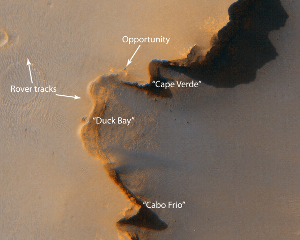Call to Mars: how NASA communicates with Curiosity
So, how can you get in touch with a rover located on Mars? Think about it - even when Mars is at the smallest distance from Earth, the signal needs to overcome fifty-five million kilometers! This is really a huge distance. But how does a small, lone rover manage to transfer its scientific data and beautiful full-color images so far and in such numbers? In the very first approximation, it looks something like this (I tried really hard):
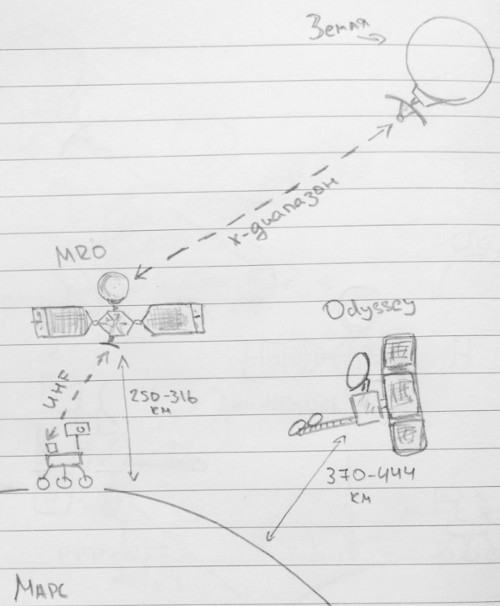
So, usually, three key “figures” participate in the process of transmitting information - one of the centers of space communications on Earth, one of the artificial satellites of Mars, and actually , the rover itself. Let's start with the old woman of the Earth, and talk about space communication centers DSN (Deep Space Network).
Any of NASA's space missions is designed to ensure that communication with the spacecraft should be possible 24 hours a day (well, or at least always, when it can be possible in principle ). Since, as we know, the Earth rotates quite quickly around its own axis, to ensure the continuity of the signal, several points are necessary for receiving / transmitting data. These points are the DSN stations. They are located on three continents and are approximately 120 degrees long from each other, which allows them to partially overlap each other’s areas of operation and, thanks to this, “keep” the spacecraft 24 hours a day. For this, when the spacecraft leaves the coverage area of one of the stations, its signal is transferred to another.
One of the DSN complexes is located in the USA (Goldstone complex), the second is in Spain (about 60 kilometers from Madrid), and the third is in Australia (about 40 kilometers from Canberra).
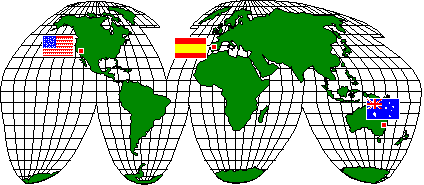
Each of these complexes has its own set of antennas, but in terms of functionality all three centers are approximately equal. The antennas themselves are called DSS (Deep Space Stations), and have their own numbering - the antennas in the USA have the numbers 1X-2X, the antennas in Australia are 3X-4X, and in Spain they are 5X-6X. So if you hear “DSS53” somewhere, you can be sure that we are talking about one of the Spanish antennas.
For communication with Mars rovers, the complex in Canberra is most often used, so let's talk about it a little more.
The complex has its own websiteon which you can find quite a lot of interesting information. For example, very soon - April 13 this year - the DSS43 antenna will be 40 years old.
In total, at the moment, the Canberra station has three active antennas: DSS-34 (with a diameter of 34 meters), DSS-43 (an impressive 70 meters) and DSS-45 (again 34 meters). Of course, over the years the center has been operating, other antennas have been used, which for various reasons have been decommissioned. For example, the very first antenna - DSS42 - was withdrawn from use in December 2000, and DSS33 (11 meters in diameter) was decommissioned in February 2002, and then moved to Norway in 2009 to continue its work as an instrument for studying the atmosphere.
The first of the mentioned working antennas, DSS34, was built in 1997 and became the first representative of a new generation of these devices. Its distinctive feature is that the equipment for receiving / transmitting and processing the signal is not located directly on the plate, but in the room under it. This made it possible to significantly lighten the plate, and also made it possible to maintain equipment without stopping the operation of the antenna itself. DSS34 is a reflector antenna, its operation scheme looks something like this:
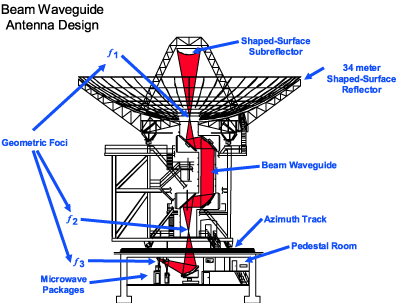
As you can see, under the antenna there is a room in which all the processing of the received signal is carried out. With a real antenna, this room is underground, so you won’t see it in the photographs. DSS34 clickable
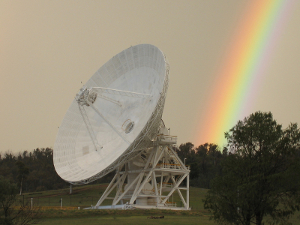
DSS43 (which will soon have an anniversary) is a much older instance, built in 1969-1973, and undergone modernization in 1987. DSS43 is the largest mobile parabolic antenna in the southern hemisphere of our planet. The massive structure weighing more than 3000 tons rotates on an oil film with a thickness of about 0.17 mm. The surface of the plate consists of 1272 aluminum panels, and has an area of 4180 square meters. DSS43, clickable
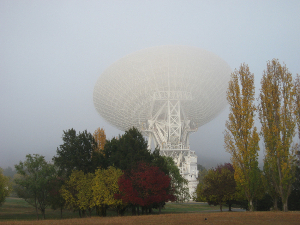
DSS45 . This antenna was completed in 1986, and was originally designed to communicate with Voyager 2, who studied Uranus. It rotates on a circular base with a diameter of 19.6 meters, using 4 wheels for this, two of which are leading. DSS45, clickable
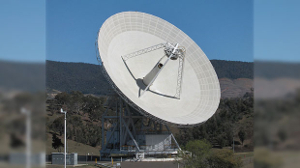
If we talk about the space communications station as a whole, we can distinguish four main tasks that it should perform:
Telemetry - receive, decode and process telemetry data coming from spacecraft. Typically, this data consists of scientific and engineering information transmitted over the air. The telemetry system receives data, monitors their changes and compliance with the norm, and transfers them to validation systems or research centers involved in their processing.
Tracking - the tracking system should provide the possibility of two-way communication between the Earth and the spacecraft, and carry out calculations of its location and velocity vector for the correct positioning of the turret.
Control- gives specialists the opportunity to transfer control commands to the spacecraft.
Monitoring and control - I allow you to monitor and control the systems of DSN itself
It should be noted that the Australian station currently serves about 45 spacecraft, so the time schedule for its work is clearly regulated, and getting extra time is not so simple. Each antenna also has the technical ability to serve up to two different devices at the same time.
So, the data that should be transmitted to the rover is sent to the DSN station, from where they are sent on their short-term (5 to 20 minutes) space journey to the Red Planet. Let's move on to the rover itself. What means of communication does he have?
Curiosity is equipped with three antennas, each of which can be used to receive and transmit information. This is a UHF antenna, LGA and HGA. [1] All of them are located on the "back" of the rover, in various places.
[1]
HGA - High Gain Antenna
MGA - Medium Gain Antenna
LGA - Low Gain Antenna
UHF - Ultra High Frequency
Since the abbreviations HGA, MGA and LGA already have the word antenna in them, I will not reassign this word to them, unlike abbreviations UHF.
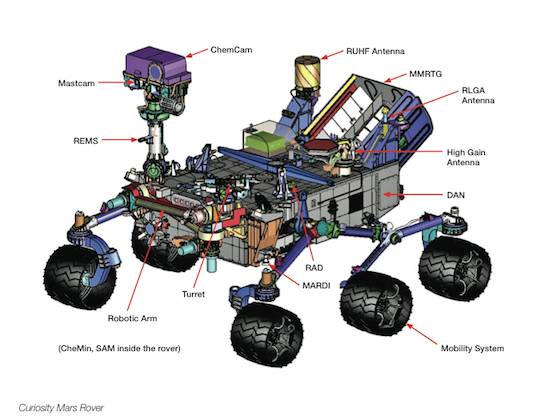
We are interested in RUHF, RLGA, and High Gain Antenna
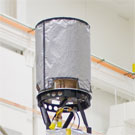 The UHF antenna is used most often. With its help, the rover can transmit data via the MRO and Odyssey satellites (which we will talk about later) at a frequency of about 400 megahertz. Using satellites to transmit a signal is preferable because they are in the field of view of DSN stations much longer than the rover itself, sitting alone on the surface of Mars. In addition, since they are much closer to the rover, the latter needs to spend less energy to transmit data. The transfer speed can reach 256kb / s for Odyssey and up to 2 Mbps for MRO. Used on most of the information coming from the Curiosity, passes it through the MRO satellite. The UHF antenna itself is located at the rear of the rover, and looks like a gray cylinder.
The UHF antenna is used most often. With its help, the rover can transmit data via the MRO and Odyssey satellites (which we will talk about later) at a frequency of about 400 megahertz. Using satellites to transmit a signal is preferable because they are in the field of view of DSN stations much longer than the rover itself, sitting alone on the surface of Mars. In addition, since they are much closer to the rover, the latter needs to spend less energy to transmit data. The transfer speed can reach 256kb / s for Odyssey and up to 2 Mbps for MRO. Used on most of the information coming from the Curiosity, passes it through the MRO satellite. The UHF antenna itself is located at the rear of the rover, and looks like a gray cylinder.
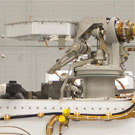 Curiosity also has an HGA, which it can use to receive commands directly from Earth. This antenna is mobile (it can be directed towards the Earth), that is, to use it, the rover does not have to change its location, just turn the HGA in the right direction, and this allows you to save energy. HGA is mounted approximately in the middle from the left side of the rover, and is a hexagon with a diameter of about 30 centimeters. HGA can transmit data directly to the Earth at a speed of about 160 bps to 34-meter antennas, or at a speed of up to 800 bps to 70-meter.
Curiosity also has an HGA, which it can use to receive commands directly from Earth. This antenna is mobile (it can be directed towards the Earth), that is, to use it, the rover does not have to change its location, just turn the HGA in the right direction, and this allows you to save energy. HGA is mounted approximately in the middle from the left side of the rover, and is a hexagon with a diameter of about 30 centimeters. HGA can transmit data directly to the Earth at a speed of about 160 bps to 34-meter antennas, or at a speed of up to 800 bps to 70-meter.
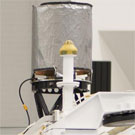 Finally, the third antenna is the so-called LGA.
Finally, the third antenna is the so-called LGA.
She sends and receives signals in any direction. LGA operates in the X-band (7-8 GHz). Nevertheless, the power of this antenna is rather small, and the transmission speed leaves much to be desired. Because of this, it is mainly used for receiving information, and not for transmitting it.
In the photo, LGA is a white turret in the foreground.
In the background is a UHF antenna.
It is worth noting that the rover generates a huge amount of scientific data, and it is not always possible to send all of them. NASA experts set priorities of importance: information with the highest priority will be transmitted in the first place, and information with a lower priority will wait for the next communication window. Sometimes part of the least important data has to be deleted altogether.
So, we found out that usually to communicate with Curiosity you need an “intermediate link” in the form of one of the satellites. Thanks to this, it is possible to increase the time during which communication with Curiosity is generally possible, and also to increase the transmission speed, since more powerful satellite antennas are capable of transmitting data to the Earth at a much higher speed.
Each of the satellites has two communication windows with a rover in each sol. Usually these windows are quite short - just a few minutes. In case of emergency, Curiosity can also contact the satellite of the European Space Agency Mars Express Orbiter.
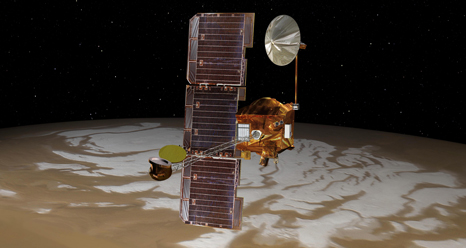
Mars Odyssey
The satellite Mars Odyssey was launched in 2001 and was originally designed to study the structure of the planet and search for minerals. The satellite has a size of 2.2x2.6x1.7 meters and a mass of more than 700 kilograms. The height of its orbit ranges from 370 to 444 kilometers. This satellite was actively used by previous mars rovers: about 85 percent of the data received from Spirit and Opportunity were transmitted through it. Odyssey can communicate with Curiosity in the UHF band. In terms of communications, it has an HGA, MGA (medium gain antenna), LGA, and a UHF antenna. Basically, for transmitting data to Earth, HGA is used, having a diameter of 1.3 meters. The transmission is carried out at a frequency of 8406 MHz, and data reception is carried out at a frequency of 7155 MHz. The angular size of the beam is about two degrees.

Arrangement of satellite instruments
Communications with rovers are carried out using a UHF antenna at frequencies of 437 MHz (transmission) and 401 MHz (reception), the data exchange rate can be 8, 32, 128 or 256 kb / s.
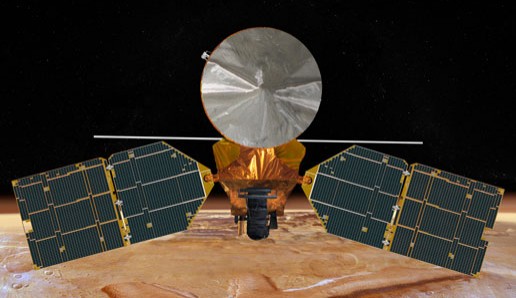
MRO
In 2006, the MRO - Mars Reconnaissance Orbiter, which today is the main source for Curiosity, joined the Odyssey satellite.
However, in addition to the work of the signalman, the MRO itself has an impressive arsenal of scientific instruments, and, most interestingly, it is equipped with a HiRISE camera, which is, in fact, a reflector telescope. At an altitude of 300 kilometers, HiRISE can take images with a resolution of up to 0.3 meters per pixel (for comparison, satellite images of the Earth are usually available with a resolution of about 0.5 meters per pixel). MRO can also create stereo surface pairs with an accuracy of mind-blowing 0.25 meters. I strongly recommend that you familiarize yourself with at least a few pictures that are available, for example, here. What, for example, is this image of Victoria Crater (clickable, the original is about 5 megabytes): I suggest that you find the Opportunity rover in the image most attentive;)

Please note that most color photographs are taken in an extended range, so if you stumble upon a photograph in which part of the surface will be bright blue-green, do not rush to engage in conspiracy theology;) But you can be sure that in different photographs the same breeds will have the same color. However, back to communication systems.
The MRO is equipped with four antennas that match the rover's antennas as intended - these are the UHF antenna, HGA and two LGA. The main antenna used by the satellite - HGA - has a diameter of three meters, and works in the X-band. It is she who is used to transmit data to Earth. The HGA is also equipped with a 100-watt signal amplifier.

1 - HGA, 3 - UHF, 10 - LGA (both LGA are mounted directly on the HGA)
Curiosity and MRO communicate using a UHF antenna, the communication window opens twice in the sol, and lasts about 6-9 minutes. MRO allocates 5GB per day for data received from rovers and stores it until it is in the field of visibility of one of the DSN stations on Earth, after which it transfers the data there. Data transfer to the rover is carried out according to the same principle. For storage of teams that should be transferred to the rover, 30 Mb / sol is allocated.
DSN stations conduct MROs for 16 hours a day (the remaining 8 hours the satellite is located on the back of Mars, and cannot exchange data, since it is closed by the planet), 10-11 of which it transmits data to Earth. Usually, the satellite operates with a 70-meter DSN antenna for three days a week, and twice with a 34-meter antenna (unfortunately it is not clear what it does in the remaining two days, but it is unlikely to have a weekend). The transmission speed can vary from 0.5 to 4 megabits per second - it decreases with the distance of Mars from the Earth and increases with the approach of two planets. Now (at the time of publication of the article) Earth and Mars are almost at the maximum distance from each other, so the transmission speed is most likely not very high.
NASA claims (there is a special widget on the satellite’s website) that over the entire time the MRO has transmitted over 187 terabits (!) Of data to the Earth - this is more than all the devices sent into space before it, combined.
So to summarize. When transferring control commands to the rover, the following occurs:
When transmitting data from the rover to Earth, all this happens in the reverse order:
I hope I was able to more or less briefly describe the process of communication with Curiosity. All this information (in English; plus a huge bunch of additional information, including, for example, fairly detailed technical reports on the principles of operation of each of the satellites) is available on various JPL sites, it is very easy to find if you know what interests you.
Please report all errors and typos in PM!

So, usually, three key “figures” participate in the process of transmitting information - one of the centers of space communications on Earth, one of the artificial satellites of Mars, and actually , the rover itself. Let's start with the old woman of the Earth, and talk about space communication centers DSN (Deep Space Network).
Space communication stations
Any of NASA's space missions is designed to ensure that communication with the spacecraft should be possible 24 hours a day (well, or at least always, when it can be possible in principle ). Since, as we know, the Earth rotates quite quickly around its own axis, to ensure the continuity of the signal, several points are necessary for receiving / transmitting data. These points are the DSN stations. They are located on three continents and are approximately 120 degrees long from each other, which allows them to partially overlap each other’s areas of operation and, thanks to this, “keep” the spacecraft 24 hours a day. For this, when the spacecraft leaves the coverage area of one of the stations, its signal is transferred to another.
One of the DSN complexes is located in the USA (Goldstone complex), the second is in Spain (about 60 kilometers from Madrid), and the third is in Australia (about 40 kilometers from Canberra).

Each of these complexes has its own set of antennas, but in terms of functionality all three centers are approximately equal. The antennas themselves are called DSS (Deep Space Stations), and have their own numbering - the antennas in the USA have the numbers 1X-2X, the antennas in Australia are 3X-4X, and in Spain they are 5X-6X. So if you hear “DSS53” somewhere, you can be sure that we are talking about one of the Spanish antennas.
For communication with Mars rovers, the complex in Canberra is most often used, so let's talk about it a little more.
The complex has its own websiteon which you can find quite a lot of interesting information. For example, very soon - April 13 this year - the DSS43 antenna will be 40 years old.
In total, at the moment, the Canberra station has three active antennas: DSS-34 (with a diameter of 34 meters), DSS-43 (an impressive 70 meters) and DSS-45 (again 34 meters). Of course, over the years the center has been operating, other antennas have been used, which for various reasons have been decommissioned. For example, the very first antenna - DSS42 - was withdrawn from use in December 2000, and DSS33 (11 meters in diameter) was decommissioned in February 2002, and then moved to Norway in 2009 to continue its work as an instrument for studying the atmosphere.
The first of the mentioned working antennas, DSS34, was built in 1997 and became the first representative of a new generation of these devices. Its distinctive feature is that the equipment for receiving / transmitting and processing the signal is not located directly on the plate, but in the room under it. This made it possible to significantly lighten the plate, and also made it possible to maintain equipment without stopping the operation of the antenna itself. DSS34 is a reflector antenna, its operation scheme looks something like this:

As you can see, under the antenna there is a room in which all the processing of the received signal is carried out. With a real antenna, this room is underground, so you won’t see it in the photographs. DSS34 clickable

some technical specifications
Broadcast:
Reception:
Positioning accuracy:
Turning speed:
Resistance to wind:
- X-band (7145-7190 MHz)
- S-band (2025-2120 MHz)
Reception:
- X-band (8400-8500 MHz)
- S-band (2200-2300 MHz)
- Ka-band (31.8-32.3 GHz)
Positioning accuracy:
- within 0.015 ° (accuracy of aiming at the sky)
- within 0.25mm (accuracy of movement of the antenna itself)
Turning speed:
- 2.0 ° / s
Resistance to wind:
- Constant wind 72km / h
- Gusts + 88km / h
- Maximum design - 160km / h
DSS43 (which will soon have an anniversary) is a much older instance, built in 1969-1973, and undergone modernization in 1987. DSS43 is the largest mobile parabolic antenna in the southern hemisphere of our planet. The massive structure weighing more than 3000 tons rotates on an oil film with a thickness of about 0.17 mm. The surface of the plate consists of 1272 aluminum panels, and has an area of 4180 square meters. DSS43, clickable

some technical specifications
Broadcast:
Reception:
Positioning accuracy:
Turning speed:
Resistance to wind:
- X-band (7145-7190 MHz)
- S-band (2025-2120 MHz)
Reception:
- X-band (8400-8500 MHz)
- S-band (2200-2300 MHz)
- L-band (1626-1708 MHz)
- K-band (12.5 GHz)
- Ku band (18-26 GHz)
Positioning accuracy:
- within 0.005 ° (accuracy of aiming at the sky)
- within 0.25mm (accuracy of movement of the antenna itself)
Turning speed:
- 0.25 ° / s
Resistance to wind:
- Constant wind 72km / h
- Gusts + 88km / h
- Maximum design - 160km / h
DSS45 . This antenna was completed in 1986, and was originally designed to communicate with Voyager 2, who studied Uranus. It rotates on a circular base with a diameter of 19.6 meters, using 4 wheels for this, two of which are leading. DSS45, clickable

some technical specifications
Broadcast:
Reception:
Positioning accuracy:
Turning speed:
Resistance to wind:
- X-band (7145-7190 MHz)
Reception:
- X-band (8400-8500 MHz)
- S-band (2200-2300 MHz)
Positioning accuracy:
- within 0.015 ° (accuracy of aiming at the sky)
- within 0.25mm (accuracy of movement of the antenna itself)
Turning speed:
- 0.8 ° / s
Resistance to wind:
- Constant wind 72km / h
- Gusts + 88km / h
- Maximum design - 160km / h
If we talk about the space communications station as a whole, we can distinguish four main tasks that it should perform:
Telemetry - receive, decode and process telemetry data coming from spacecraft. Typically, this data consists of scientific and engineering information transmitted over the air. The telemetry system receives data, monitors their changes and compliance with the norm, and transfers them to validation systems or research centers involved in their processing.
Tracking - the tracking system should provide the possibility of two-way communication between the Earth and the spacecraft, and carry out calculations of its location and velocity vector for the correct positioning of the turret.
Control- gives specialists the opportunity to transfer control commands to the spacecraft.
Monitoring and control - I allow you to monitor and control the systems of DSN itself
It should be noted that the Australian station currently serves about 45 spacecraft, so the time schedule for its work is clearly regulated, and getting extra time is not so simple. Each antenna also has the technical ability to serve up to two different devices at the same time.
So, the data that should be transmitted to the rover is sent to the DSN station, from where they are sent on their short-term (5 to 20 minutes) space journey to the Red Planet. Let's move on to the rover itself. What means of communication does he have?
Curiosity
Curiosity is equipped with three antennas, each of which can be used to receive and transmit information. This is a UHF antenna, LGA and HGA. [1] All of them are located on the "back" of the rover, in various places.
[1]
HGA - High Gain Antenna
MGA - Medium Gain Antenna
LGA - Low Gain Antenna
UHF - Ultra High Frequency
Since the abbreviations HGA, MGA and LGA already have the word antenna in them, I will not reassign this word to them, unlike abbreviations UHF.

We are interested in RUHF, RLGA, and High Gain Antenna
 The UHF antenna is used most often. With its help, the rover can transmit data via the MRO and Odyssey satellites (which we will talk about later) at a frequency of about 400 megahertz. Using satellites to transmit a signal is preferable because they are in the field of view of DSN stations much longer than the rover itself, sitting alone on the surface of Mars. In addition, since they are much closer to the rover, the latter needs to spend less energy to transmit data. The transfer speed can reach 256kb / s for Odyssey and up to 2 Mbps for MRO. Used on most of the information coming from the Curiosity, passes it through the MRO satellite. The UHF antenna itself is located at the rear of the rover, and looks like a gray cylinder.
The UHF antenna is used most often. With its help, the rover can transmit data via the MRO and Odyssey satellites (which we will talk about later) at a frequency of about 400 megahertz. Using satellites to transmit a signal is preferable because they are in the field of view of DSN stations much longer than the rover itself, sitting alone on the surface of Mars. In addition, since they are much closer to the rover, the latter needs to spend less energy to transmit data. The transfer speed can reach 256kb / s for Odyssey and up to 2 Mbps for MRO. Used on most of the information coming from the Curiosity, passes it through the MRO satellite. The UHF antenna itself is located at the rear of the rover, and looks like a gray cylinder. Curiosity also has an HGA, which it can use to receive commands directly from Earth. This antenna is mobile (it can be directed towards the Earth), that is, to use it, the rover does not have to change its location, just turn the HGA in the right direction, and this allows you to save energy. HGA is mounted approximately in the middle from the left side of the rover, and is a hexagon with a diameter of about 30 centimeters. HGA can transmit data directly to the Earth at a speed of about 160 bps to 34-meter antennas, or at a speed of up to 800 bps to 70-meter.
Curiosity also has an HGA, which it can use to receive commands directly from Earth. This antenna is mobile (it can be directed towards the Earth), that is, to use it, the rover does not have to change its location, just turn the HGA in the right direction, and this allows you to save energy. HGA is mounted approximately in the middle from the left side of the rover, and is a hexagon with a diameter of about 30 centimeters. HGA can transmit data directly to the Earth at a speed of about 160 bps to 34-meter antennas, or at a speed of up to 800 bps to 70-meter.  Finally, the third antenna is the so-called LGA.
Finally, the third antenna is the so-called LGA.She sends and receives signals in any direction. LGA operates in the X-band (7-8 GHz). Nevertheless, the power of this antenna is rather small, and the transmission speed leaves much to be desired. Because of this, it is mainly used for receiving information, and not for transmitting it.
In the photo, LGA is a white turret in the foreground.
In the background is a UHF antenna.
It is worth noting that the rover generates a huge amount of scientific data, and it is not always possible to send all of them. NASA experts set priorities of importance: information with the highest priority will be transmitted in the first place, and information with a lower priority will wait for the next communication window. Sometimes part of the least important data has to be deleted altogether.
Odyssey and MRO satellites
So, we found out that usually to communicate with Curiosity you need an “intermediate link” in the form of one of the satellites. Thanks to this, it is possible to increase the time during which communication with Curiosity is generally possible, and also to increase the transmission speed, since more powerful satellite antennas are capable of transmitting data to the Earth at a much higher speed.
Each of the satellites has two communication windows with a rover in each sol. Usually these windows are quite short - just a few minutes. In case of emergency, Curiosity can also contact the satellite of the European Space Agency Mars Express Orbiter.
Mars odyssey

Mars Odyssey
The satellite Mars Odyssey was launched in 2001 and was originally designed to study the structure of the planet and search for minerals. The satellite has a size of 2.2x2.6x1.7 meters and a mass of more than 700 kilograms. The height of its orbit ranges from 370 to 444 kilometers. This satellite was actively used by previous mars rovers: about 85 percent of the data received from Spirit and Opportunity were transmitted through it. Odyssey can communicate with Curiosity in the UHF band. In terms of communications, it has an HGA, MGA (medium gain antenna), LGA, and a UHF antenna. Basically, for transmitting data to Earth, HGA is used, having a diameter of 1.3 meters. The transmission is carried out at a frequency of 8406 MHz, and data reception is carried out at a frequency of 7155 MHz. The angular size of the beam is about two degrees.

Arrangement of satellite instruments
Communications with rovers are carried out using a UHF antenna at frequencies of 437 MHz (transmission) and 401 MHz (reception), the data exchange rate can be 8, 32, 128 or 256 kb / s.
Mars reconnaissance orbiter

MRO
In 2006, the MRO - Mars Reconnaissance Orbiter, which today is the main source for Curiosity, joined the Odyssey satellite.
However, in addition to the work of the signalman, the MRO itself has an impressive arsenal of scientific instruments, and, most interestingly, it is equipped with a HiRISE camera, which is, in fact, a reflector telescope. At an altitude of 300 kilometers, HiRISE can take images with a resolution of up to 0.3 meters per pixel (for comparison, satellite images of the Earth are usually available with a resolution of about 0.5 meters per pixel). MRO can also create stereo surface pairs with an accuracy of mind-blowing 0.25 meters. I strongly recommend that you familiarize yourself with at least a few pictures that are available, for example, here. What, for example, is this image of Victoria Crater (clickable, the original is about 5 megabytes): I suggest that you find the Opportunity rover in the image most attentive;)

Please note that most color photographs are taken in an extended range, so if you stumble upon a photograph in which part of the surface will be bright blue-green, do not rush to engage in conspiracy theology;) But you can be sure that in different photographs the same breeds will have the same color. However, back to communication systems.
The MRO is equipped with four antennas that match the rover's antennas as intended - these are the UHF antenna, HGA and two LGA. The main antenna used by the satellite - HGA - has a diameter of three meters, and works in the X-band. It is she who is used to transmit data to Earth. The HGA is also equipped with a 100-watt signal amplifier.

1 - HGA, 3 - UHF, 10 - LGA (both LGA are mounted directly on the HGA)
Curiosity and MRO communicate using a UHF antenna, the communication window opens twice in the sol, and lasts about 6-9 minutes. MRO allocates 5GB per day for data received from rovers and stores it until it is in the field of visibility of one of the DSN stations on Earth, after which it transfers the data there. Data transfer to the rover is carried out according to the same principle. For storage of teams that should be transferred to the rover, 30 Mb / sol is allocated.
DSN stations conduct MROs for 16 hours a day (the remaining 8 hours the satellite is located on the back of Mars, and cannot exchange data, since it is closed by the planet), 10-11 of which it transmits data to Earth. Usually, the satellite operates with a 70-meter DSN antenna for three days a week, and twice with a 34-meter antenna (unfortunately it is not clear what it does in the remaining two days, but it is unlikely to have a weekend). The transmission speed can vary from 0.5 to 4 megabits per second - it decreases with the distance of Mars from the Earth and increases with the approach of two planets. Now (at the time of publication of the article) Earth and Mars are almost at the maximum distance from each other, so the transmission speed is most likely not very high.
NASA claims (there is a special widget on the satellite’s website) that over the entire time the MRO has transmitted over 187 terabits (!) Of data to the Earth - this is more than all the devices sent into space before it, combined.
Conclusion
So to summarize. When transferring control commands to the rover, the following occurs:
- JPL specialists send commands to one of the DSN stations.
- During a communication session with one of the satellites (most likely, it will be an MRO), the DSN sends him a set of commands.
- The satellite stores the data in the internal memory, and is waiting for the next communication window with the rover.
- When the rover is in the access zone, the satellite transmits control commands to it.
When transmitting data from the rover to Earth, all this happens in the reverse order:
- The rover stores its scientific data in internal memory and awaits the nearest communication window with the satellite.
- When the satellite is available, the rover transmits information to it.
- The satellite receives data, stores it in its memory, and expects the availability of one of the DSN stations
- When the DSN becomes available, the satellite sends it the received data.
- Finally, after receiving the signal, the DSN decodes it, and sends the received data to those for whom it is intended.
I hope I was able to more or less briefly describe the process of communication with Curiosity. All this information (in English; plus a huge bunch of additional information, including, for example, fairly detailed technical reports on the principles of operation of each of the satellites) is available on various JPL sites, it is very easy to find if you know what interests you.
Please report all errors and typos in PM!
Only registered users can participate in the survey. Please come in.
Do you like the style of presentation of the material?
- 74.4% Yes, I enjoy reading more articles in the same style 1301
- 14% Yes, but I would like more technical details 245
- 6.4% Yes, but I would like less technical details and more “live” presentation 113
- 4.1% Nothing Outstanding - Style As Style 73
- 0.8% No 15

